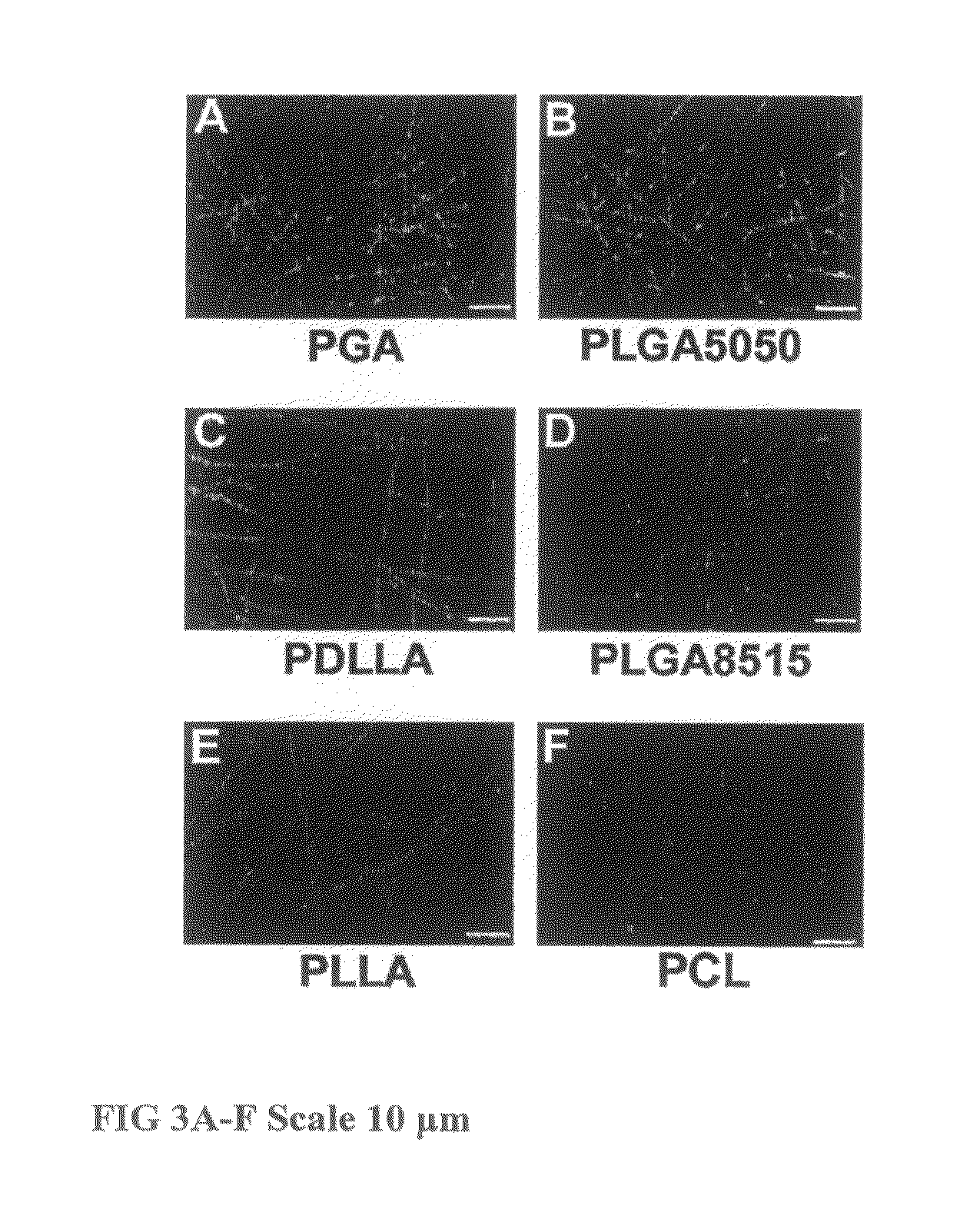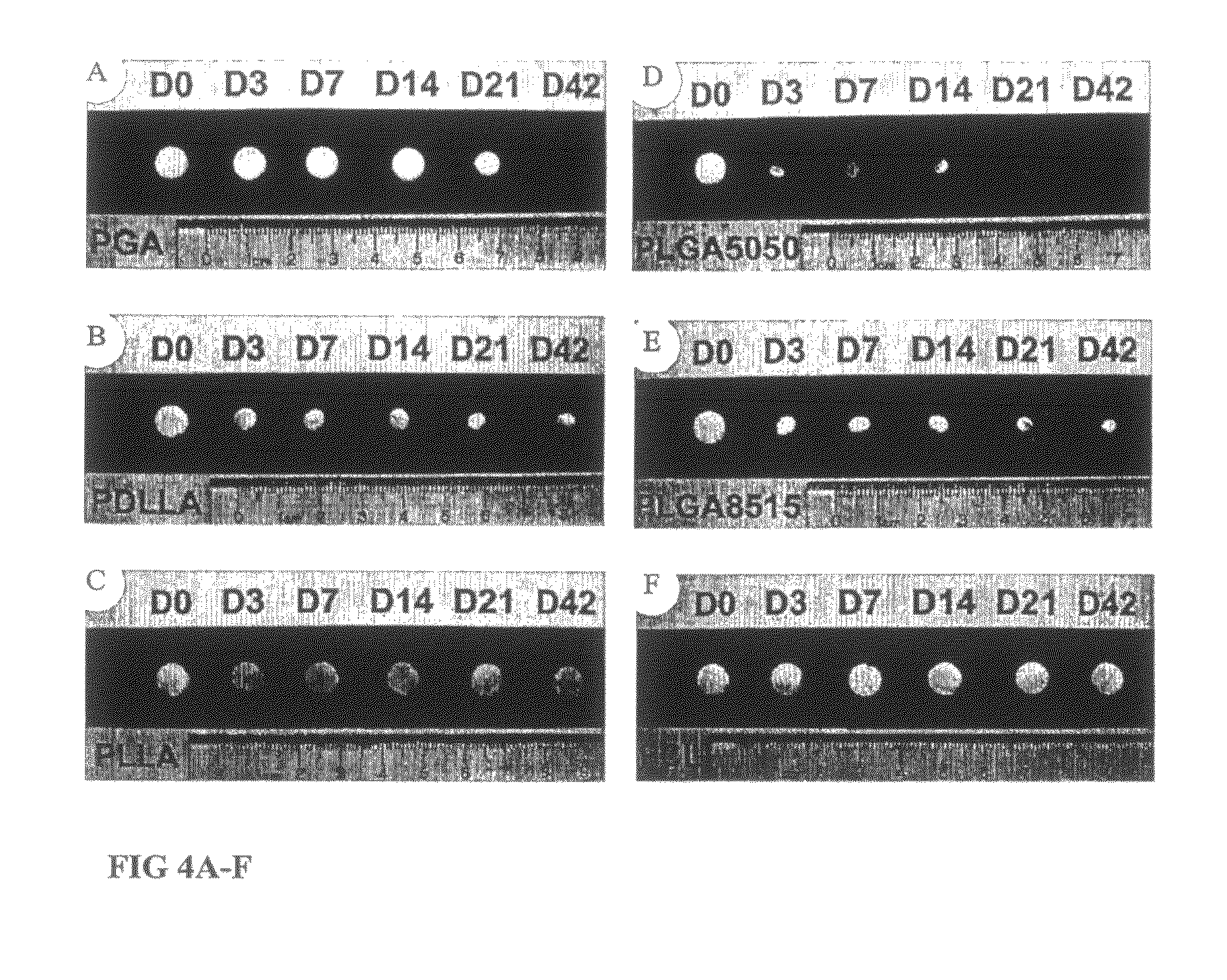Tissue engineered cartilage, method of making same, therapeutic and cosmetic surgical applications using same
a technology cartilage, which is applied in the field of tissue engineered cartilage, can solve the problems of less resistance of cartilage generated by seeding a hydrogel or preformed three-dimensional polymeric scaffold to compressive force, joint pain and loss of mobility, and despecification of seeded chondocytes, etc., and achieve the effect of uniform diameter
- Summary
- Abstract
- Description
- Claims
- Application Information
AI Technical Summary
Benefits of technology
Problems solved by technology
Method used
Image
Examples
example 1
Isolation and Culture of Bone Marrow-derived hMSCs
[0146]With approval from the Institutional Review Board of Thomas Jefferson University, bone marrow-derived hMSCs were obtained from the femoral heads of patients undergoing total hip arthroplasty, and processed as previously described (Noth U, et al. J Orthop Res 2002;20:1060-9; Haynesworth S E, et al. Bone 1992;13:81-8; and Wang M L, et al. J Orthop Res 2002;20:1175-84). Briefly, whole bone marrow was curetted from the exposed cutting plane of the femoral neck, washed extensively in Dulbecco's Modified Eagle's medium (DMEM; BioWhittaker, Walkersville, Md.), separated from contaminating trabecular bone fragments and other tissues using a 20-gauge needle attached to a 10-cc syringe, and cultured in DMEM, 10% fetal bovine serum (FBS; Premium Select, Atlanta Biologicals, Atlanta, Ga.) from selected lots (Caterson E J, et al. Mol Biotechnol 2002;20:245-56), and antibiotics (50 μg / mL streptomycin, 50 IU / mL of penicillin; Cellgro, Herndon...
example 2
Fabrication of Electrospun Nanofibrous PCL Scaffolds
[0147]Nanofibrous scaffolds were fabricated according to an electrospinning process described previously (Li W J, et al. J Biomed Mater Res 2003;67A:1105-14). Briefly, PCL polymer was dissolved in an organic solvent mixture (1:1) of tetrahydrofuran (THF; Fisher, Pittsburgh, Pa.) and N,N, dimethylformamide (DMF; Fisher, Pittsburgh, Pa.) at a final concentration of 0.14 g / mL. The polymer solution was delivered through the electrospinning apparatus at a constant flow rate of 0.4 mL / h under an applied 0.6 kV / cm charge density, resulting in a 144 cm2 mat with an approximate thickness of 1 mm. To remove residual organic solvent, the non-woven polymer mat was placed within a vacuum chamber for 48 h, and subsequently stored in a desiccator. Prior to cell seeding, squares measuring 10 mm×10 mm×1 mm were fashioned from the electrospun mat, sterilized by ultraviolet irradiation for 30 min per side in a laminar flow hood, and pre-wetted for 24...
example 3
Seeding and Differentiation of hMSCs on PCL Scaffolds
[0148]Pre-processed nanofibrous PCL scaffolds were placed in 24-well tissue culture plates (Corning Glass Works, Corning, N.Y.) coated with 0.3% poly(2-hydroxyethyl methacrylate) (poly HEMA; Polysciences, Warrington, Pa.) to prevent normal cell attachment to tissue culture polystyrene. Cellular scaffolds were incubated at 37° C. for 4 h to allow MSCs to diffuse into and adhere to the scaffold before the addition of 2 mL of culture medium to each well. During the 4 h incubation, 20 μL of serum containing culture medium was applied every 30 min to each cellular scaffold to prevent the constructs from drying. For chondrogenic differentiation studies, 4×105 hMSCs were seeded per PCL scaffold and maintained in a chemically defined medium containing serum-free DMEM, 50 μg / mL ascorbate, 0.1 μM dexamethasone, 40 μg / mL L-proline, 100 μg / mL sodium pyruvate, ITS-plus (Collaborative Biomedical Products, Cambridge, Mass.), antibiotics, and 10 ...
PUM
| Property | Measurement | Unit |
|---|---|---|
| diameter | aaaaa | aaaaa |
| diameter | aaaaa | aaaaa |
| Young's modulus | aaaaa | aaaaa |
Abstract
Description
Claims
Application Information
 Login to View More
Login to View More - R&D
- Intellectual Property
- Life Sciences
- Materials
- Tech Scout
- Unparalleled Data Quality
- Higher Quality Content
- 60% Fewer Hallucinations
Browse by: Latest US Patents, China's latest patents, Technical Efficacy Thesaurus, Application Domain, Technology Topic, Popular Technical Reports.
© 2025 PatSnap. All rights reserved.Legal|Privacy policy|Modern Slavery Act Transparency Statement|Sitemap|About US| Contact US: help@patsnap.com



